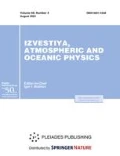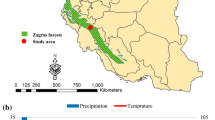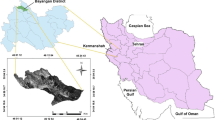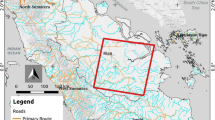Abstract
The possibility of increasing the efficiency of forest vegetation mapping is studied using Landsat multitemporal satellite images of medium spatial resolution. To simplify the process of supervised satellite-image classification, the method of automated generation of reference samples is applied based on forest inventory materials. Using the test forest areas of the southern part of Yenisei Siberia, it is demonstrated that native and secondary stands of different ages, from which regeneration series of dark coniferous and light coniferous forests are developed in different forest growing conditions, are mapped as a result of the classification of multiseasonal images with a sufficient level of significance (Kappa coefficient more than 0.7).



Similar content being viewed by others
REFERENCES
Aksenov, D.E. and Yaroshenko, A.U., Space images for forestry and forest management, Earth from Space, 2009, no. 1, pp. 10–15.
Bartalev, S., Erchov, D., Isaev, A., and Belward, A., A new SPOT4-Vegetation derived land cover map of Northern Eurasia, Int. J. Remote Sens., 1999, vol. 24, no. 9, pp. 1977–1982.
Bartalev, S.A., Egorov, V.A., Ershov, D.V., Isaev, A.S., Loupian, E.A., Plotnikov, D.E., and Uvarov, I.A., Satellite mapping of vegetation cover in Russia using MODIS spectroradiometer data, Sovrem. Probl. Distantsionnogo Zondirovaniya Zemli Kosmosa, 2011, vol. 8, no. 4, pp. 285–302.
Berlyant, A.M., Gedymin, A.V., Kelner, Yu.G., et al., Spravochnik po kartografii (Cartography: A Reference Book), Moscow: Nedra, 1988.
Bontemps, S., Defourney, P., van Bogaert, E., and Arino, O., GLOBCOVER2009 Products Description and Validation Report. http://due.esrin.esa.int/globcover/Land-Cover2009/GLOBCOVER2009_Validation_Report_2.2.pdf.
Britsyna, M.P., The relief and soil-forming species in the central part of the Krasnoyarsk Region), in Prirodnoe raionirovanie tsentral’noi chasti Krasnoiarskogo kraia i nekotorye voprosy prirodnogo khozyaistva (Natural Zoning of the Central Part of the Krasnoyarsk Region and Some Issue of the Natural Management), Moscow: AN USSR, 1962.
Buzykin, A.I., Cherednikova, Yu.S., and Perevoznikova, V.D., Forest growth zoning and forest types, in Regional’nye problemy ekosistemnogo lesovodstva (Regional Problems of Ecosystem Forestry), Onuchin, A.A., Ed., Krasnoyarsk: Inst. lesa im. V.N. Sukacheva SO RAN, 2007, pp. 15–45.
Classifier of thematic problems of the assessment of natural resources and environment that can be solved using tools of remote sensing of the Earth, in Zemlya iz kosmosa. Naibolee effektivnye resheniya (The Earth from Space: Most Efficient Solutions), 2009, no. 3, pp. 46–53.
Danilova, I.V., Ryzhkova, V.A., and Onuchin, A.A., Using of satellite imagery, digital elevation model (DEM) and field data for mapping of forest regeneration dynamics), Geod. Kartogr., 2013, no. 9, pp. 25–32.
ERDAS Field Guide, Fifth Edition, Atlanta, Georgia, USA: ERDAS Inc., 1999.
Gavrilyuk, E.A. and Ershov, D.V., Thematic mapping of forest species from Landsat-TM\ETM+ imagery), in Aerokosmicheskie metody i geoinformatsionnye tekhnologii v lesovedenii i lesnom khozyaistve (Aerospace Methods and Geoinformation Technologies in Forestry), Moscow: TsEPL RAN, 2013, pp. 112–115.
Gong, P., Wang, J., Yu, L., Zhao, Y.C., Zhao, Y., Liang, L., Niu, Z.G., Huang, X.M., Fu, H.H., Liu, S., et al., Finer resolution observation and monitoring of global land cover: First mapping results with Landsat TM and ETM+ data, Int. J. Remote Sens., 2013, vol. 34, pp. 2607–2654.
Hansen, M.C., Potapov, P.V., Moore, R., Hancher, M., Turubanova, S.A., Tyukavina, A., Thau, D., et al., High-resolution global maps of 21st-century forest cover change, Science, 2013, vol. 342, no. 6160, pp. 850–853. doi 10.1126/science.1244693
Isaev, A.S., Knyazeva, S.V., Puzachenko, M.J., and Chernenkova, T.V., The use of satellite data for monitoring of forest biodiversity), Issled. Zemli Kosmosa, 2009, no. 2, pp. 55–66.
Kashkin, V.B. and Sukhinin, A.I., Distantsionnoe zondirovanie zemli iz kosmosa. Tsifrovaya obrabotka izobrazhenii: uch. posob. dlja vuzov (Remote Sensing of the Earth from Space. Digital Image Processing: A Manual for Universities), Moscow: Logos, 2001.
Korets, M.A., Danilova, I.V., and Cherkashin, V.P., in Remote indication of the forestry strucure, in Regional’nye problemy ekosistemnogo lesovodstva (Regional Problems of Ecosystem Forestry), Onuchin, A.A., Ed., Krasnoyarsk: Inst. lesa im. V.N. Sukacheva SO RAN, 2007, pp. 52–68.
Kozoderov, V.V. and Dmitriev, E.V., Aerospace sensing of the soil–vegetation cover: Models, algorithmic and software tools, ground-based validation), Issled. Zemli Kosmosa, 2010, no. 1, pp. 69–86.
Marchukov, V.S. and Stytsenko, E.A., Interpretation of vegetation cover using spectral and temporal characteristics, Issled. Zemli Kosmosa, 2012, no. 1, pp. 77–88.
Monserud, R.A. and Leemans, R., Comparing global vegetation maps with the Kappa statistic, Ecol. Modeling, 1992, vol. 62, pp. 275–293.
Puzachenko, Yu.G., Krenke, A.N., Puzachenko, M.Yu., and Sandelskii, R.B., General principles of the use of multispectral remote data for forestry studies, in Aerokosmicheskie metody i geoinformatsionnye tekhnologii v lesovedenii i lesnom khozyaistve (Aerospace Methods and Geoinformation Technologies in Forestry), Moscow: TsEPL RAN, 2013, pp. 59–62.
Richards, J.A. and Xiuping, J., Remote Sensing Digital Image Analysis: An Introduction, Birkhäuser, 2005.
Ryzhkova, V. and Danilova, I., GIS-based classification and mapping of forest site condition and vegetation, Bosque, 2012, vol. 33, no. 3, pp. 293–297.
Tateishi, R., Uriyangqai, B., Al-Bilbisi, H., Ghar, M.A., Tsend-Ayush, J., Kobayashi, T., Kasimu, A., et al., Production of global land cover data—GLCNMO, Int. J. Digital Earth, 2011, vol. 1, pp. 22–49.
ACKNOWLEDGMENTS
This work was supported by the Government of Russian Federation (grant no. 14.B25.31.0031) and the Russian Foundation for Basic Research (grant no. 15-04-04013).
Author information
Authors and Affiliations
Corresponding author
Additional information
Translated by A. Barkhash
Rights and permissions
About this article
Cite this article
Danilova, I.V., Korets, M.A. & Ryzhkova, V.A. Mapping Age Stages of Forest Vegetation Based on an Analysis of Landsat Multiseasonal Satellite Images. Izv. Atmos. Ocean. Phys. 54, 997–1007 (2018). https://doi.org/10.1134/S0001433818090116
Received:
Published:
Issue Date:
DOI: https://doi.org/10.1134/S0001433818090116




